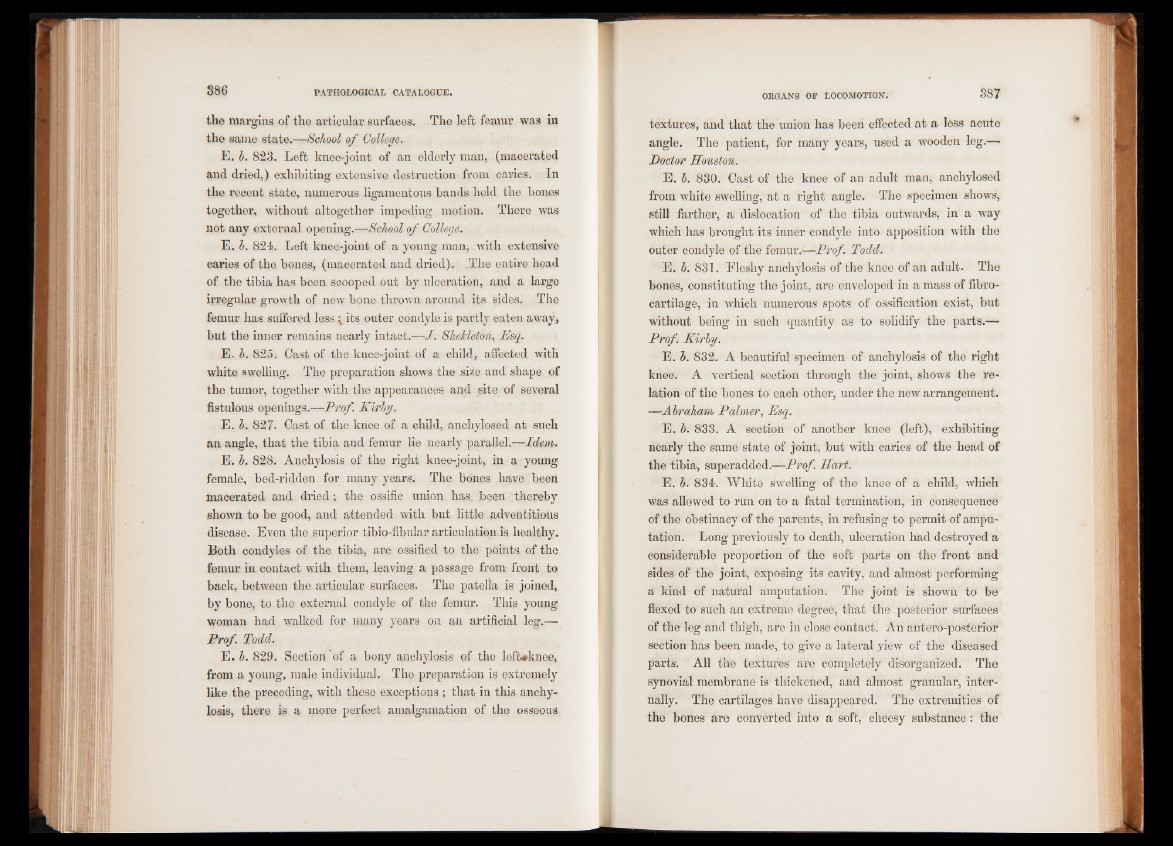
the margins of the articular surfaces. The left femur was in
the same state.—School of College.
E. 1). 823. Left knee-joint of an elderly man, (macerated
and dried,) exhibiting extensive destruction from caries. In
the recent state, numerous ligamentous bands held the bones
together, without altogether impeding motion. There was
not any external opening.—School of College.
E. b. 824. Left knee-joint of a young man, with extensive
caries of the bones, (macerated and dried) . The entire head
of the tibia has been scooped out by ulceration, and a large
irregular growth of new bone thrown around its sides. The
femur has suffered less its outer condyle is partly eaten away,
but the inner remains nearly intact.—J. Shehleton, Esq.
E. h. 825. Cast of the knee-joint of a child, affected with
white swelling. The preparation shows the size and shape of
the tumor, together with the appearances and site of several
fistulous openings.—Prof. Kirby.
E. b. 827. Oast of the knee of a child, anchylosed at such
an angle, that the tibia and femur lie nearly parallel.—Idem.
E. b. 828. Anchylosis of the right knee-joint, in a young
female, bed-ridden for many years. The bones have been
macerated and dried; the ossifie union has. been thereby
shown to be good, and attended with but little adventitious
disease. Even the superior tibio-fibular articulation is healthy.
Both condyles of the tibia, are ossified to the points, of the
femur in contact with them, leaving a passage from front to
back, between the articular surfaces. The patella is joined,
by bone, to the external condyle of the femur. This young
woman had walked for many years on an artificial leg.—
Prof. Todd.
E. b. 829. Section of a bony anchylosis of the left#knee,
from a young, male individual. The preparation is extremely
like the preceding, with these exceptions ; that in this anchylosis,
there is a more perfect amalgamation of the osseous
textures, and that the union has been effected at a less acute
angle. The patient, for many years, used a wooden leg.—
Doctor Houston.
E. b. 830. Cast of the knee of an adult man, anchylosed
from white swelling, at a right angle. The specimen shows,
still farther, a dislocation of the tibia outwards, in a way
which has brought its inner condyle into apposition with the
outer condyle of the femur.—Prof. Todd.
E. b. 831. Fleshy anchylosis of the knee of an adult. The
bones, constituting the joint, are enveloped in a mass of fibro-
cartilage, in which numerous spots of ossification exist, but
without being in such quantity as to solidify the parts.—
Prof. Kirby.
E. b. 832. A beautiful specimen of anchylosis of the right
knee. A vertical section through the joint, shows the relation
of the bones to each other, under the new arrangement.
—Abraham Palmer, Esq.
E. b. 833. A section of another knee (left), exhibiting
nearly the same state of joint, but with caries of the head of
the tibia, superadded.—Prof. Hart.
E. b. 834. White swelling of the knee of a child, which
was allowed to run on to a fatal termination, in consequence
of the obstinacy of the parents, in refusing to permit of amputation.
Long previously to death, ulceration had destroyed a
considerable proportion of the soft parts on the front and
sides of the joint, exposing its cavity, and almost performing
a kind of natural amputation. The joint is shown to be
flexed to such an extreme degree, that the posterior surfaces
of the leg and thigh, are in close contact. An antero-posterior
section has been made, to give a lateral yiew of the diseased
parts. All the textures are completely disorganized. The
synovial membrane is thickened, and almost granular, internally.
The cartilages have disappeared. The extremities of
the bones are converted into a soft, cheesy substance: the